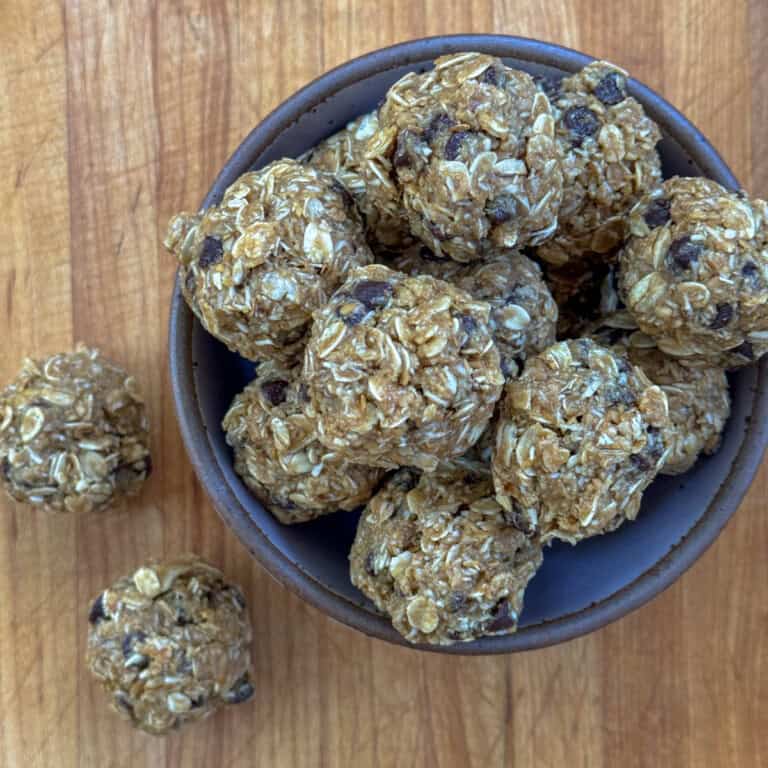This post was first published in June 2018, and updated June 2021.
Want to keep snacks simple and structured? Download our resource, 20 Simple Snack Ideas + 5 Tips, and have this information on hand!
I love talking with parents about snacks and what the word “snack” means to them. We all approach food in different ways, shaped by our own upbringing, relationship with food, and the nutrition information we gather throughout our lives.
People have certain images that they think of when they hear the word “snack.” I find, many people think of “snacks” as particular foods, such as crackers and chips. Others, when they hear the word “snack,” think of “snacking,” a verb that seems to mean mindlessly eating between meals.
We have a fast-paced culture that often doesn’t support the idea of taking the time to stop and re-fuel and, for many, snacks can be an afterthought.

However, snacks are important!
Snacks, or mini-meals, are often needed to meet the energy needs of growing bodies. Having a snack between meals, can be a way to keep energy levels up and provide opportunities to try new foods.
By having set meal and snack times, children can arrive at eating times hungry, but not too hungry. Parents can approach snacks in a way that fuels children’s high energy needs and “doesn’t ruin their dinner.”
5 Snack Tips for Kids (and Adults, too!):
1. Prioritize Sit-Down Snacks: It’s important for food to be given a certain amount of time and energy. Food is one of our 5 basic needs, but all too often falls to the bottom of our to-do list.
Snacks do not need to take long, but it’s important to stop, sit down and enjoy refueling, while not doing other things. This helps children retain their innate ability of eating intuitively. They can listen to their hunger and fullness if food is prioritized.
This can be at a park, “Let’s sit down for a minute and have a snack.” or at the swimming pool this summer, “Come sit on your towel and have something to eat.” As the parent, you are determining when it’s time to eat, what is served, and where. If you want to read more about your feeding jobs as parents check out our post – Family Feeding: The Long Haul.

2. Consider the Timing of Snacks: It’s important to think through the timing of meals and snacks. Many children do well fueling up every 2-4 hours.
To encourage eating a variety of foods, it’s important for children to arrive at meals and snacks hungry. Arriving at a meal hungry, is like going to the grocery store hungry, everything looks good and it’s hard to stick to the list. Right? If we arrive at a meal hungry, we’re more likely to eat a variety of foods to meet our energy needs, rather than sticking to just familiar foods.
On the other hand, if a well-balanced snack is close to a meal time or children “graze” between meals, it can interfere with food acceptance. By having meals and snacks every 2-4 hours, you are providing a structure to assist your kids in arriving to eating times hungry, but not famished.
For many, lunch is around 12:00 pm and dinner is around 6:00 pm. With 6 or more hours between these two meals, an afternoon snack around 3:00 pm becomes really important. This need is compounded when there are after-school activities between lunch and dinner.
To meet high energy needs of growing children, an afternoon snack may be the size of a second lunch. Do you have questions about how to approach the timing of snacks with teens? Check out these post about feeding teens: Feeding Teens: Slowly Taking Down the Scaffolding and 5 Tips to Nurture Body Confidence and Trust in Kids.

3. Pair Protein and Carbohydrates: The 3 macronutrients, carbohydrates, protein, and fat, each affect our energy levels at different rates after eating. Carbohydrates give us quick energy and, depending on the amount eaten, provide energy for the next 30 – 60 min.
Fruits, vegetables, and starches provide carbohydrates. Protein takes longer than carbohydrates to empty out of our stomachs and doesn’t give us immediate energy.
Protein kicks in when carbohydrates fall off and provides more long-lasting energy. Yogurt, milk, cheese, meats, nuts, eggs, and beans contain protein.
Lastly, dietary fat provides the most long-lasting energy. When we include fat in a snack, the snack can stick with us for 3-4 hours, again depending on the amount eaten. Many of the protein-rich foods such as nuts, cheese, yogurt, nut butters, eggs, and meats also contain fat.
So, if you pair a protein/fat-rich food with a carbohydrate-rich food, such as apple and peanut butter, cheese and fruit, trail mix, or no-bake energy bites, you have a mini-meal with long-lasting energy. Looking for snack ideas? Check out these fantastic posts by Elizabeth: On the Go Summer Time Snacks and More Summertime Snacks!

4. Offer New Foods at Snack Time: Do you have a picky eater and feel frustrated with the lack of food acceptance at dinner time? Snacks are a great time to offer new foods. Sometimes us parents can get in a rut of only offering easily accepted foods (think fishy crackers) at snack times.
Instead, we can capitalize on snack times by offering new or not readily accepted foods. I think dinner is often elevated to a higher status in our minds than other eating times. We expect children to try new foods and eat the largest amount of food at dinner.
Dinner can be tough for young children. Dinner is close to bedtime and their fatigue may play a role in not eating very much and not trying new foods. It’s typical for young children not to eat a lot at dinner time, they are tired and have eaten enough at their other eating times.
Knowing this, it may make sense to expose children to new or not as accepted foods at other eating times of the day and snack time can be a great time to experiment in a low pressure way.
Do you want more information on how to help a picky eater? Check out our posts: Grasshoppers & Ways to Support Your Picky Eater and Picky Eating: If Pressure Doesn’t Work, What Does?

5. Keep it Easy: These suggestions are meant to make things easier, not more complicated. I’m a big fan of keeping food simple. We need to spend some time thinking, preparing, and eating food, but it doesn’t need to take up all of our time.
I keep snacks fairly simple at my house. I loved Elizabeth’s suggestions, because they are quick and take little prep time. My favorite snack is apple with peanut butter (we do sunflower butter at out house because my oldest daughter has a tree nut and peanut allergy).
Want to keep snacks simple and structured? Download our resource, 20 Simple Snack Ideas + 5 Tips, and have it on hand!
More blog posts you’ll find helpful

We’re Elizabeth & Anna!
It’s great to have you here. We’re registered dietitians and we share tips to support you in raising kids with a healthy relationship with food.





